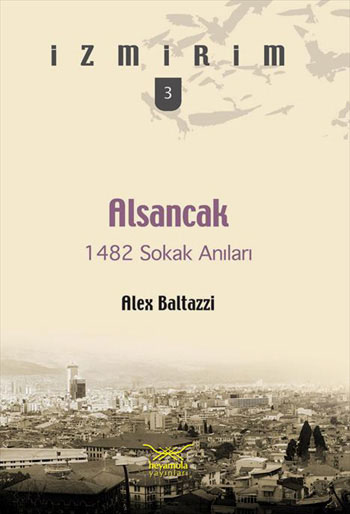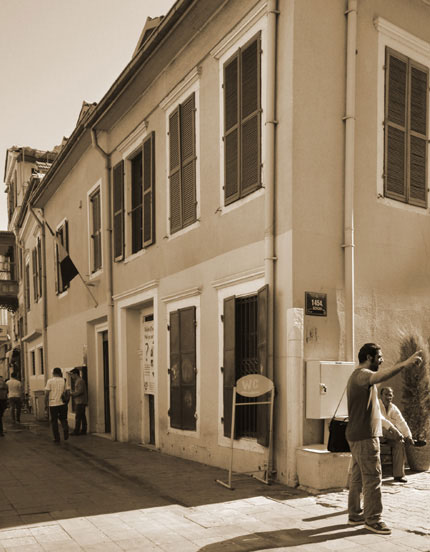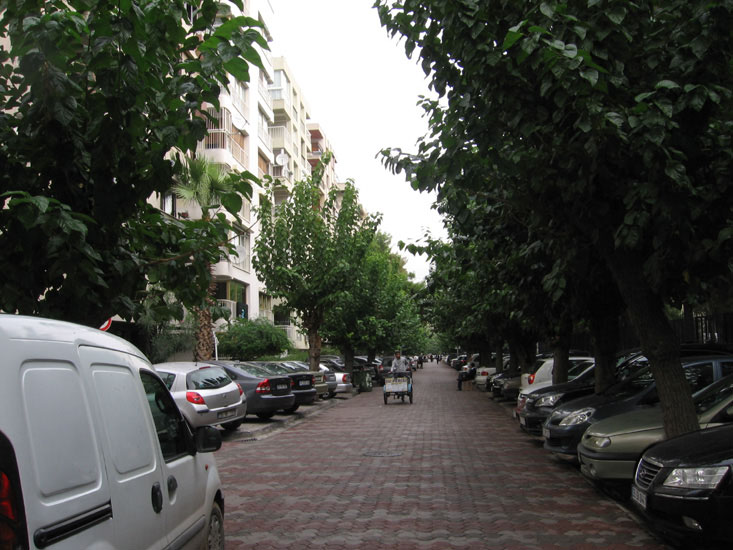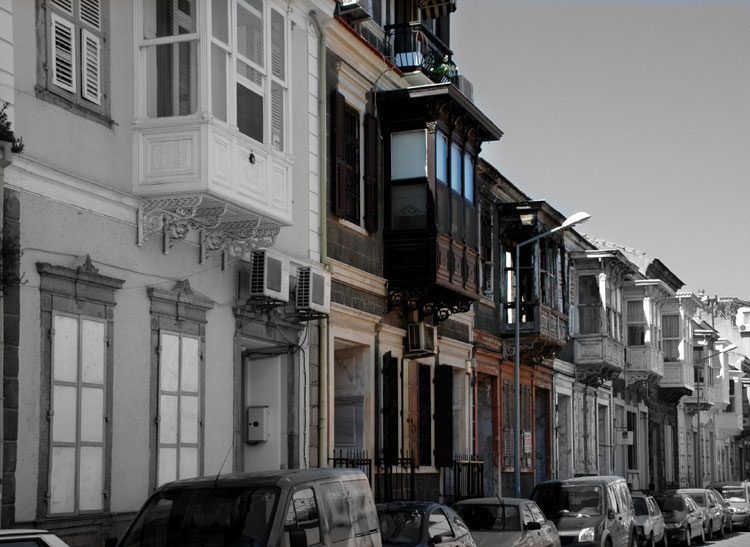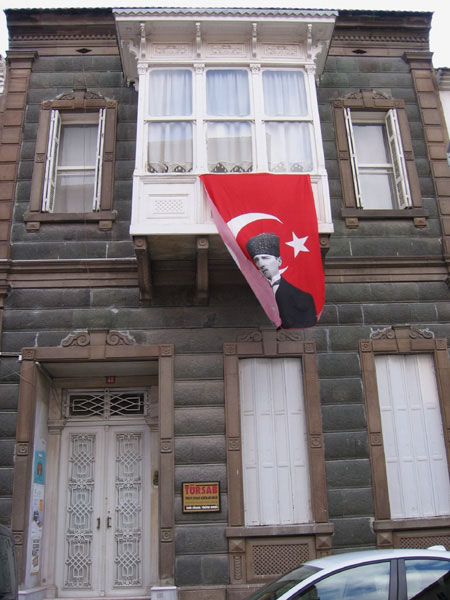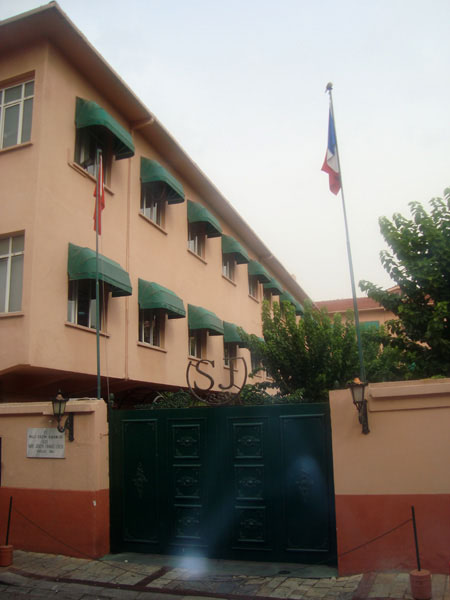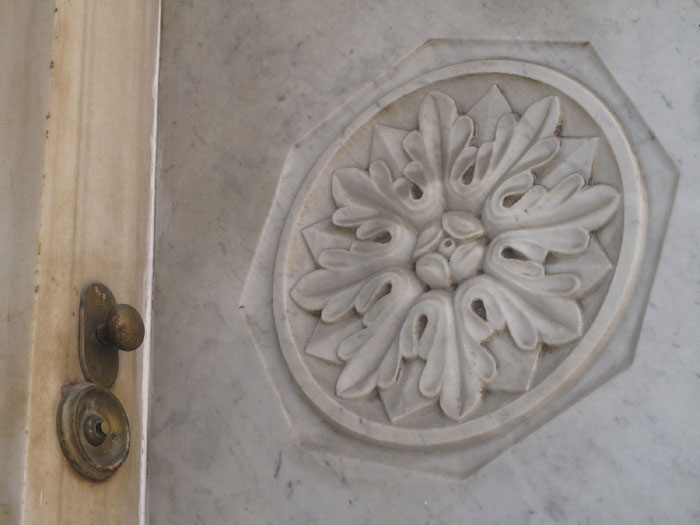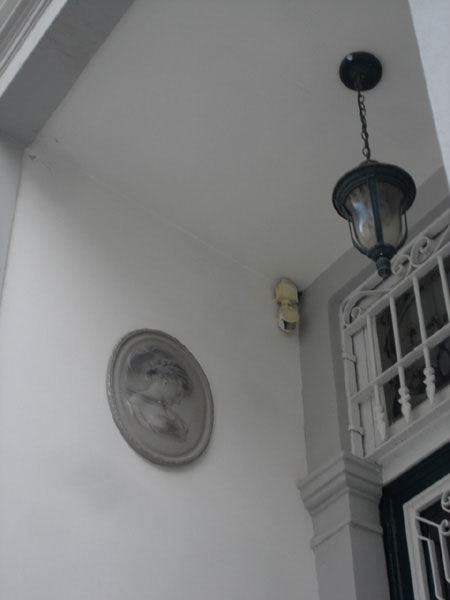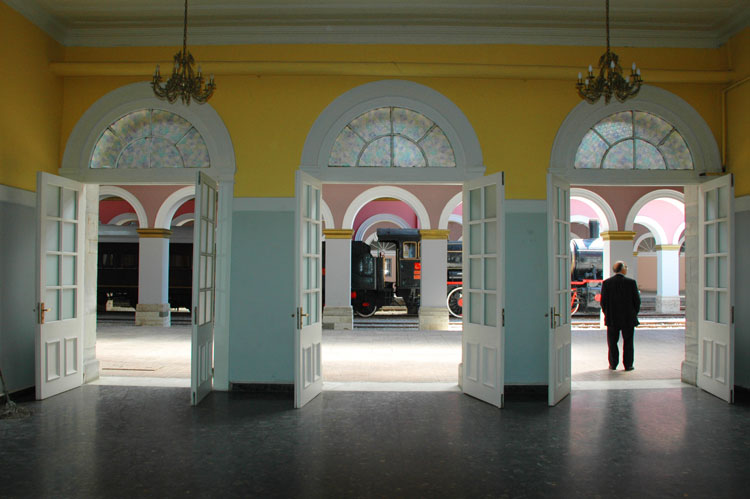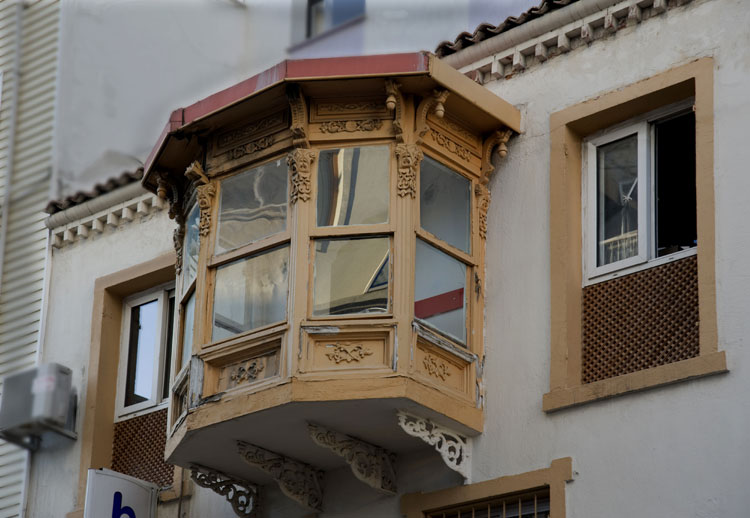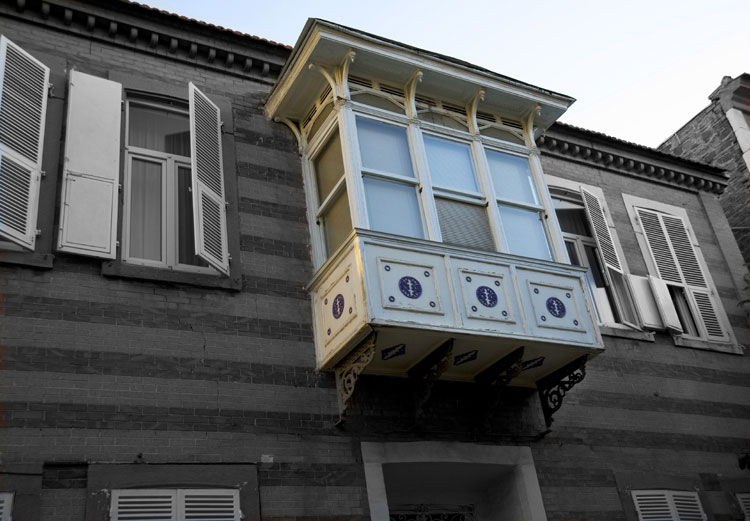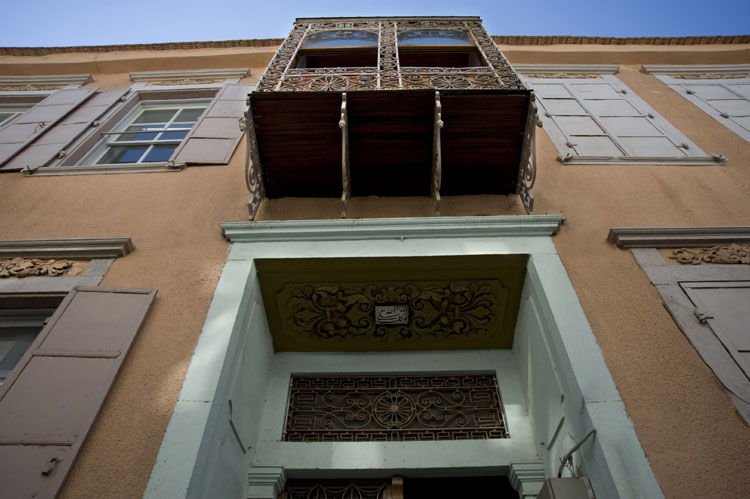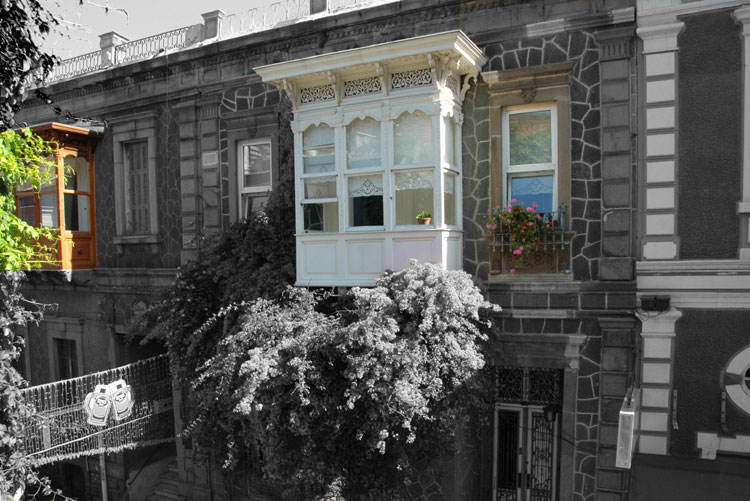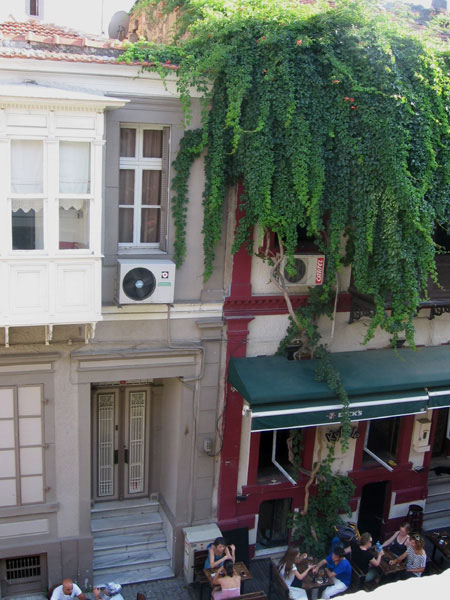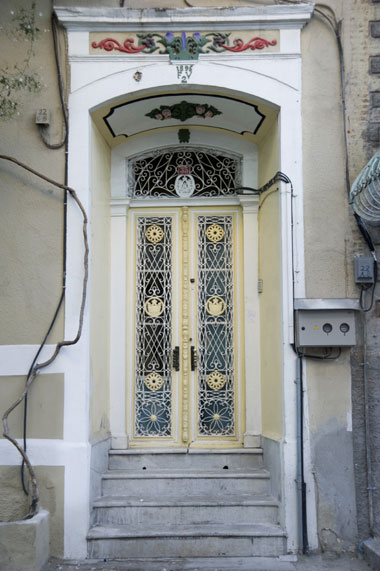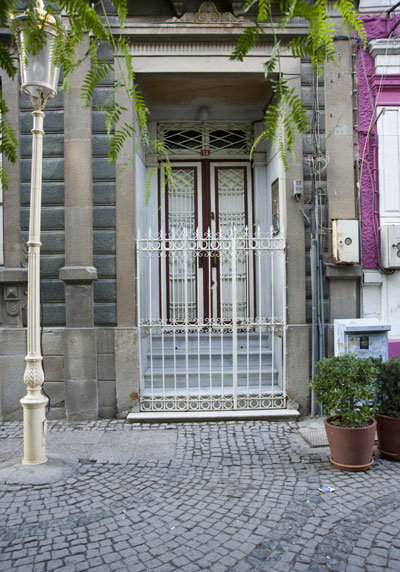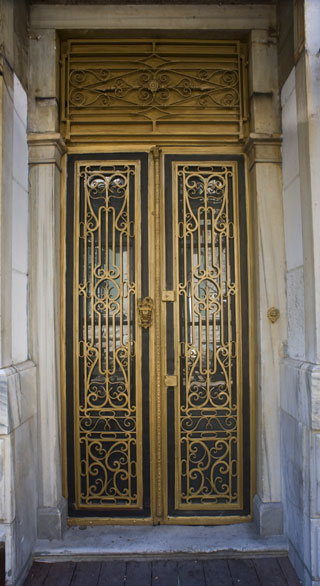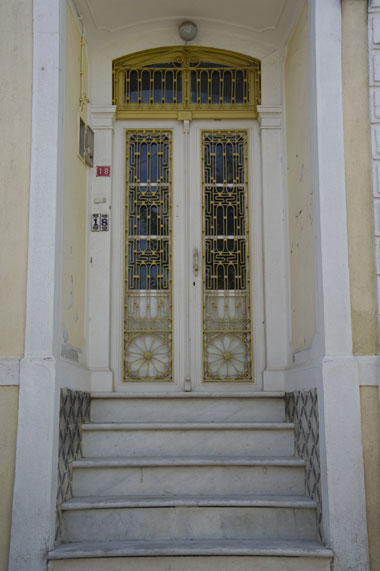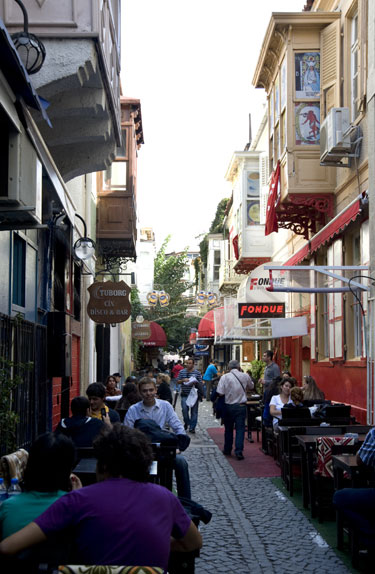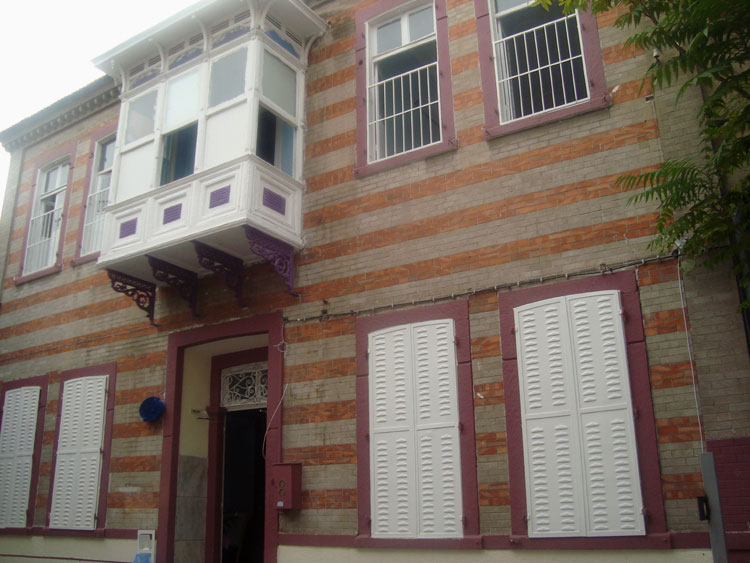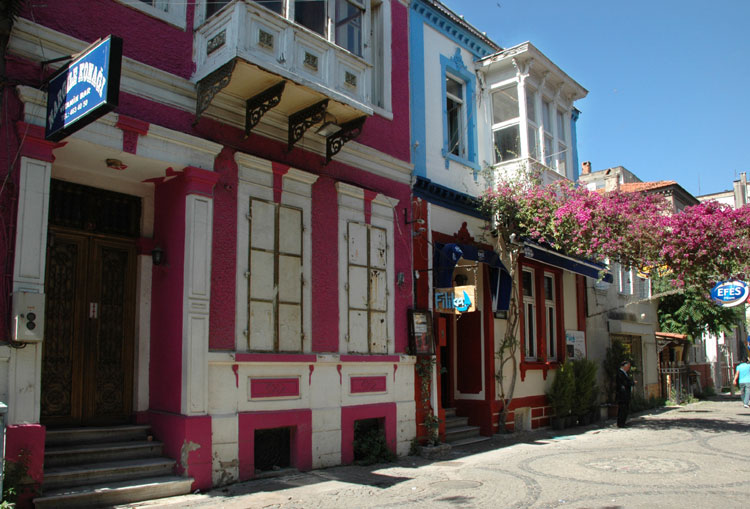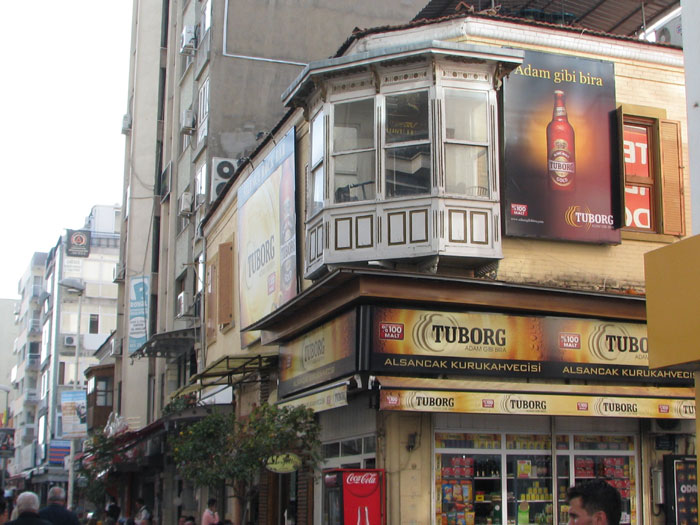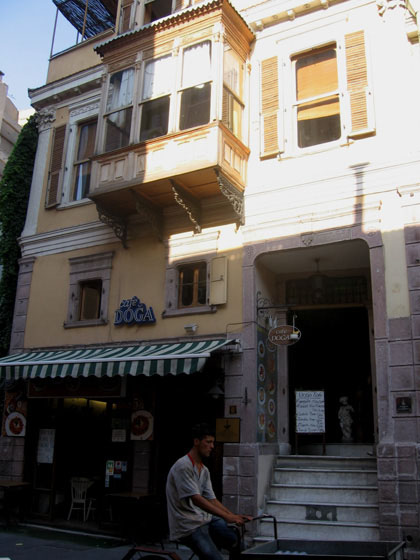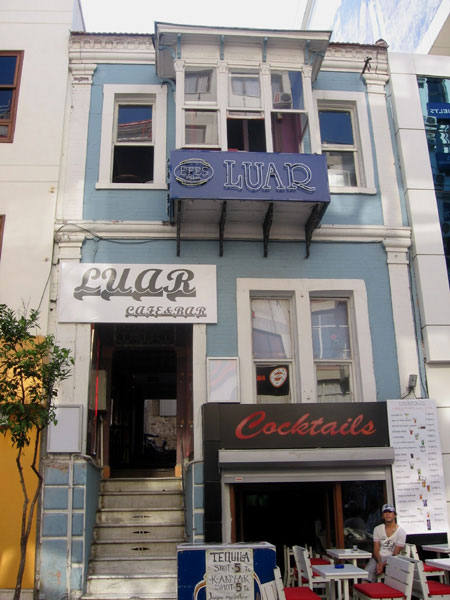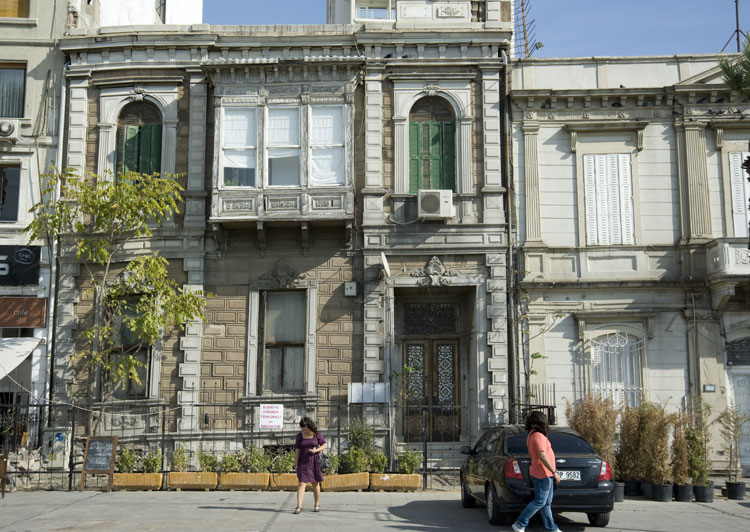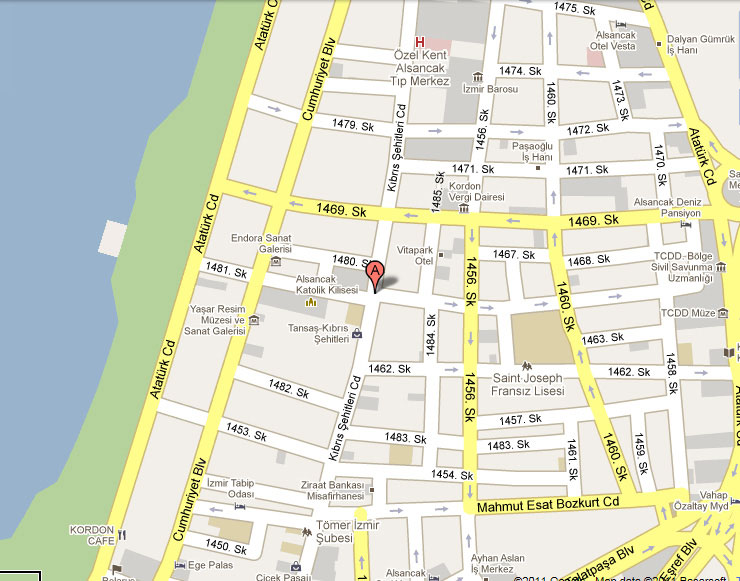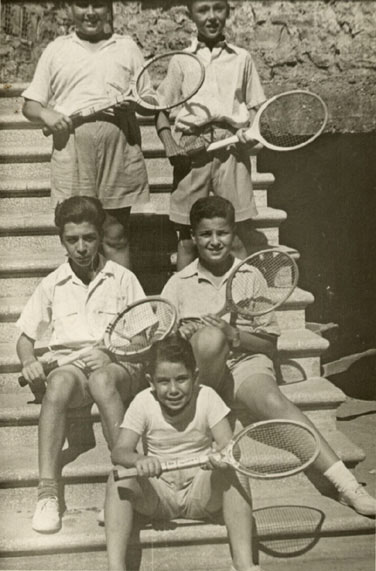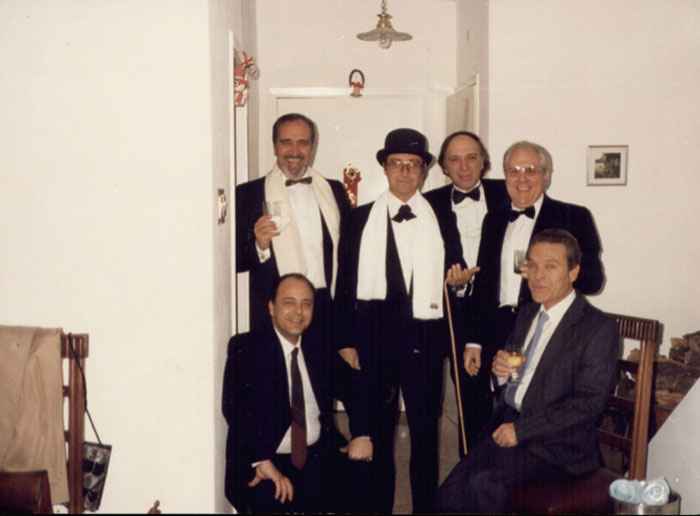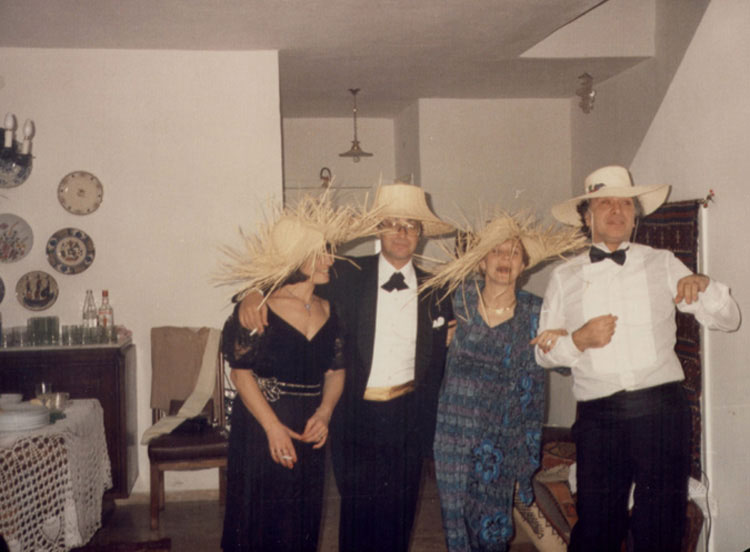Interview of Alex Baltazzi, the author of Alsancak: 1482 Sokak Anıları [Alsancak: Memories from 1482 street], Heyamola publications, March 2011
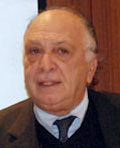 |
1- What was your chief motivation in writing this book? How long has this project been in your head?
As you know I have a passion for the Levantine heritage and in your site on the bottom of my recollections there are many of my writings as the Chians, Boudja, Bornova, Bayraklı, Seydikoy, the Importance of Izmir as port city etc. Alsancak was missing and I had the idea to write about it as well as for Pera etc (I content myself for the time being with my more tourism minded Istanbul the Queen of the cities, and West tour au feminin, Goddesses, Queens, Prophetesses, Nymphes, Amazons, Female Saints etc (a historical heritage including the Amazon Smyrna and its environs) and my various interventions at conferences and symposiums as this of Italiani di Istanbul, Izmirli Olmak etc.
However for Alsancak 1482 sokak I was requested from the Heyamola Yayınları (Editions) to do it. Heyamola last year ran a project in Istanbul covering 40 quarters and 40 writers which had some success and wished to repeat it in Izmir with the support of the Izmir Municipality. The contract was made on the end of January. There was some conditions, it should not be over 70 pages of the A4 and of limited number of photos of about 30.
2- Do you think the Izmir Municipality does a good job in honestly appraising the present and past of this city? Do you think the series of historical books published by them and others play an important part in filling gaps in the analysis compared with the past. Any books that stand out for you?
Yes of course, the Municipality is doing a good job but actually it looks like the production of new editions is slowing down. Besides I am expecting that these authors bring some new researches and be more open minded to the multicultural heritage. In this series of Izmirim, that my book was also published under, my friend the journalist and author Nedim Attila in his edition Gaziemir gave plenty of citations on me, based on my writings on Seydiköy with some of my innovative ideas why the Dutch families preferred Seydiköy and my discovery of the two Madamas.
Modesty apart I am trying hard on my writings to research and check many sources and bring also my own ideas. As you will see in my Alsancak book, I elaborated on the subject of the old names of the streets such as Aliotti, Petrocochino, Moelhasen bringing an opinion that these streets got their names probably as these families were also the owners of the majority of the land (arsa) of these streets. It is a new theory which I havent encountered before in any author. Same thing for the naming of the cumbalı evler [houses with covered balconies] as Sakız Rum Evi [Chian Greek houses]. Many authors were stating that their architectural style (mimari tip) was so. I made some researches outlined in my book and I come to a conclusion that they were called such as they were built by the Chiote ustas [master builders]. The same thing for Bornova; it was always described by recent authors including Giles Milton (Paradise Lost) as mainly Levantine in population, in its more limited definition principally English, although as mentioned by Kararas the great Greek families such as the Mavrogordatos were there since the XIIIth centuries and many others such as the Kanalakis (indicated by many authors as Russian) Kana, Zacharof, Petrocochino, Psyachi, Marcopoulo, Matzouranis, Solomonidis, Kiriakidis etc. all being Greek.
Until recently the Armenian Bardisbanian owner of the Yeşil Köşk was called Pandispanya (I am happy having contributed to its correction) and the great Armenian wealthy society of Papasians, Zipcys, Iplikcian, Simonian, Savalan, Gasparian, was quite ignored. I am happy that my article Bornova for which I am mainly grateful to Karara brought a light on all that and to see that the Vienna relatives as Mrs Saiko of the Papasians/Zipcys reading it brought more additional information. When such things happen it is the summit of satisfaction for a conscious author.
3- Can you paint me a general picture of Alsancak as you were growing up?
To paint a general picture of Alsancak will be difficult for me as it will be necessary for me to reflect with a great introspection something that is too close to you, you fail to analyze it as you have an indisputable sense of property and this is what happens to me, in as far as my Alsancak is concerned. I give you an example with the growing of the traffic when some new lights were installed close to home. I was in the car and habitude being a mauvaise conseilliere [bad example] I passed when they was not green. A car with an Istanbul license plate passed by me and the driver rightly pointed this out to me. I replied ok but this is my quarter (bu benim mahalle) I was wrong of course but I think this spontaneous reply explain everything.
4- How does Alsancak of the 1950s compares to that of the 1970s and the 1990s? What has it lost, what has it gained?
Many changes but not as catastrophic as many may think. Unfortunately many of the cumbali evler, a great character of the quarter have disappeared, but the neighbourhood still retains a warm atmosphere of joy, of welcome and with the increased visibility of the young generation, gained a new colour of independence, and joie de vivre with the multitude of cafes, bars which replaced the inhabitants of the old houses, also described in my book.
5- Can you tell me about your former neighbours, who were they, what did they do, and are you still in touch with any of these old Alsancak families?
In my youth the neighbourhood was not limited to the neighbours of the same street but of the quarter in a certain sense as distances were all within walking distance and there were considerably fewer people. But I had many friends living at 1482 street (ex-Gayret, and previous to that, ex-Petrocochino) and I remember well the Mirzan family (former house) with whose members Jeannot and Claude I still have relations. From the Sireilles family, as written in my book, Nico was my classmate at St Joseph who later emigrated to Australia and recently came to visit me. Our beloved pharmacist Mr Kosta Fornetti1 with his niece Theano have also migrated away. In Gazi Kadınlar street, of the Fantasia family, I still have relations with Pierette married to Benito Triches who we lost recently. In my book I mentioned that opposite our house used to live the well know doctor Lütfi Sabri. Last week I was stopped in the street by a middle-aged lady who I didnt know. She congratulated me for my book and said I am the daughter of the doctor Lütfi Sabri. I used to live in Gazi Kadınlar street during the 1948-50s period. This was an emotional moment bringing back old memories. Many of course such as Mrs Brussick and François (mistakenly referred to as Michel in my book) Guidici, all relatives of my dear friends the Dutilhs, and who have all alas passed away.
In the Serafettin Bey Caddesi (former Boulevard Aliotti) with the cumbalı houses of the Chiot ustas was a very familiar street as my school of St Joseph is still there. My friend Peter Papi used to live there in the big Serra/Papi house, now his house is on 1482 Sokak. Mlle Papanio a friend of my mother, the Titos a descendant along with our contributor Fabio Tito, had a house here as well as the Simes family. Teachers such as Blackburn and Mlle de Sain as well as Mrs Wagner on the Mesudiye street have all since passed away and their descendants should be abroad. The Schlossers family, whose descendants still live in Izmir, in whose house later lived the Wagner family.
The Micallef, and the Musako families of Bornova sokak still have relatives, who are friends of mine, in our city. Mrs Creon (who used to live in the Dermond house) is, if I am not mistaken, in England as well as the Galdies and the Aicolina families who used to live in the English houses (as described by the author Prokopiu) in the vicinity of the Alsancak station and Mahmut Esat Bozkurt street of today, where my own parents also died. Of the Hale family, of the same quarter, my friend Cedric Hale still lives in Alsancak at the 1381 sokak.
6- Can you also mention some of the former residents of another street that clearly means a lot to you, no 1482 (ex Gayret, ex-ex Petrochochino)?
To speak more about 1482 sokak ex Gayret, ex Petrocochino now to be called Muzaffer İzgu is quite an obligation as I born there at the corner with Mesudiye now Kıbrıs Şehitler Caddesi at my maternal grandfather Jean Exarques house and the street was in the past called with the name of my maternal great great grandmother: Petrocochino. When we were living there in the 1950s my mother used to tell me that these Petrocochinos were our relatives and a great Chios family. I owe to this street and to my mother my first researches on my family starting at Chios and then going on. In the book, briefly as I could, I related the first Petrocochinos in Izmir in 1724 and their relatives the Baltazzi in 1746 as well as the interesting short history of the 10 children of Emanuel Baltazzi and Catherine Petrocochino. I feel the necessity to describe often be of my family or not, the activities of these families coming from abroad and which were so useful to the commercial expansion of the port trade, industry, banking etc.
It is an unfortunate fact that some writers place a negative political slant when dealing with the Izmir Levantines of the past. In the same Izmirim series of Heyemola books, a writer dealing with the history of a quarter of Izmir writes about the Belgians of the Göztepe Tramway Company stating that they became owners of the Hamidiye Company in a very tricky and under-hand way and terminates by adding Günümüzde borsa cambazlıklarına parmak ısırtacak kadar maharetle yapılmış olan bu oyun, azınlıkların bu ülkenin değerlerinden nasıl yararlaranıp sömürdekleri ibret verici bir belgedir [This game played with such cunning that even todays tricky stock market traders would envy, is proof and a lesson for us all of how these minorities exploited the resources of this country]. Consequently it is necessary to bring an objective light on facts like this. I wish to be able to concentrate time in the future for researches and writings on subjects like this including the histories of the much too discussed port of Izmir, tramways, sea liaisons in the gulf etc.
7- Can you describe the former ethnic and socio-economic mixture of different parts of Alsancak? Do you think history tends to over-simplify these distributions with maps of the time with labels such as Frank Quarter?
We have to accept that these populations were mainly living in separate quarters, but not as ghettos and by time there were some mixing as also emphasized by Herve Georgelin but in the economical life as described Willy Sperco they were in daily contact considering that many producers of the main agricultural products for export were turks. My family bought many çiftliks [farms] from their friends the Karaosmanoğlu. In the sports field, such as riding, the Evliyazade were frequenting the Levantines as well as the city governor Rahmi Bey. The Sultans where hosted by the Whittalls, the Baltazzis and the Papasians.
Yes I prefer the evidence of testimonies to maps.
8- How much did the Great Fire of 1922 affect even the zone of Alsancak that was spared the flames? Do you have any family stories you can pass on to us from this era, you heard from your elders?
I am not a specialist of this but I can say that the fire spared about the whole old Punta quarter starting from the Hopital Français to about the Aydın Railways Station and a part of the Quais but streets close the actual British Consulate as the emplacement of the actual Mahmut Esat Bozkurt, where my father died in 1979 and my mother in 1989, were burnt. As described in my book page 28, my family lost at the Frank Quarter at the Rue des Verreries our Baltazzi Han which was burnt down. I mentioned all our locataires [companies sharing the same han] (as indicated in the Indicateur Commercial of 1898-99) as well, which includes known names such as Jolys, Robolys, Datodis, Werrys, Manussos Companies etc. and the Smyrna branch of the Ottoman Bank. The Italian Government gave us an indemnity but like all indemnities, this was inferior to the real value of the Han.
My familys comments were that this was a Catastrophe and having lived the whole of the Second World War in Athens, they blamed the wars between countries and peoples. My own feelings go to the innocent civilians who died during the fire events and where not saved by the foreign military ships in the bay. How many they were exactly? It seems that both writers and history are not objectively interested in that. They should!
9- Do you think local municipal and government policies since 1922 have at times been to the detriment of the development of Alsancak?
No I do not think so - If we consider the pre-1922 buildings there have been real efforts to recreate in the sections razed by the fire a modern city with urbanistic plans with foreigners as advisors. We have to praise persons such as Behçet Uz for the Kültürpark, the actual Fair grounds, and the main avenues such as Mustafa Bey Caddesi mentioned in my book. I have just one gripe, that being the Centrale Italian School should had been kept and not demolished in 1944 due to the new street requirements as officially it was stated at the time.
Regarding the old houses of the Punta section and the Kordon we were living well until about the 1970s. Amongst friends I remember living on the Kordon was Aslan Kontente and his family, carpet merchants for many years, in the imposing former Jacquignon house, a family who for a long time were engaged in construction material supplies. Then the demolition of houses to be replaced by fashionable apartment blocks can be considered as a sin by many. I quote from an extract from page 17 of my book: çarpık yapılaşma da vahşi yüzünü gösteriyor, müteahhitler eski evleri yıkıp apartman yapıyor ev sahibine de bir hatta iki kat veriyorlardi. Kimse zamanında DUR demesini bilmedi. Böylece güzelim kordonnun, ikinci kordonun ve birçok sokağın güzel, tarihi evlerin çoğu yok oldu [The developers destroyed the old houses to build new apartment blocks and gave the house owners one or even two floors in this building in exchange. Nobody knew how to say stop at the time. In this way a lot of fine and historic houses on the kordon, parallel and other streets, became history]. At the time it was also difficult for the owners of these old houses to maintain and repair them, and our authorities should have intervened and with intelligent laws and projects give support to preserve these buildings and prevent their loss.
10- Do you think there is enough local appreciation of the architectural legacy of the fire spared buildings of Alsancak? Do you think more could be done to preserve, prevent visual pollution, even promote cultural tourism?
Not enough but there is a sensibility at least to preserve what still stands even it is not used as habitation any more. It looks quite difficult but I wouldnt say impossible to envisage people wishing to still live there (particularly in Gazi Kadınlar and 1482 sokak) in a house surrounded by cafes, clubs and accept the noise created by them particularly the evenings. There is actually a serious restoration project supported by our authorities and the Municipality providing credits etc. and it looks like we will be able to enjoy some restored buildings in time, particularly in the Serafeddin Bey Caddesi and Bornova Sokak.
11- Can you tell us more about your more recent life in Alsancak.
My recent life in Alsancak has not of course been as dynamic as my youth: tennis at both clubs Alliance and Kültürpark and the night-life at the Kültürpark Clubs of my youth, related in my book, but now a more quiet life with my wife Saadet (Hapiness, she merits this name) living in a not too noisy street facing the beautiful gardens of Namık Kemal Lisesi (ex Nea Evangeliki Scholi) at a little distance of the cafes/restaurants of Musta Bey, of which I am an habitué as they are not far from my office. What I liked so much of Alsancak where I have been living since the beginning of the 1950s is that when you live there you have the possibility to reach home, office and amusements all on foot. The Italian cultural and friendship Association of which I am the President, being in the old part close to Gazi Kadınlar and 1482 sokak it is always a pleasure to walk to, through the old Mesudiye and thus refresh my memories.
12- Are you optimistic about the future of Alsancak? If you had the power what changes would you bring? Have some of these changes you envisaged have happened in the recent past?
Yes I am optimist and became more optimistic when I see so many youngsters. Especially the Izmirli girls are famous in Turkey for their beauty and modernism. Of course as an Izmirli and being in the tourism sector I have had many requests for many years all emphasized in the book and particularly in the last section at my Izmir dream but I see that in the last few years a big majority share this vision and this a big hope for the Future.
Interview conducted by Craig Encer, June 2010.

As you know I have a passion for the Levantine heritage and in your site on the bottom of my recollections there are many of my writings as the Chians, Boudja, Bornova, Bayraklı, Seydikoy, the Importance of Izmir as port city etc. Alsancak was missing and I had the idea to write about it as well as for Pera etc (I content myself for the time being with my more tourism minded Istanbul the Queen of the cities, and West tour au feminin, Goddesses, Queens, Prophetesses, Nymphes, Amazons, Female Saints etc (a historical heritage including the Amazon Smyrna and its environs) and my various interventions at conferences and symposiums as this of Italiani di Istanbul, Izmirli Olmak etc.
However for Alsancak 1482 sokak I was requested from the Heyamola Yayınları (Editions) to do it. Heyamola last year ran a project in Istanbul covering 40 quarters and 40 writers which had some success and wished to repeat it in Izmir with the support of the Izmir Municipality. The contract was made on the end of January. There was some conditions, it should not be over 70 pages of the A4 and of limited number of photos of about 30.
2- Do you think the Izmir Municipality does a good job in honestly appraising the present and past of this city? Do you think the series of historical books published by them and others play an important part in filling gaps in the analysis compared with the past. Any books that stand out for you?
Yes of course, the Municipality is doing a good job but actually it looks like the production of new editions is slowing down. Besides I am expecting that these authors bring some new researches and be more open minded to the multicultural heritage. In this series of Izmirim, that my book was also published under, my friend the journalist and author Nedim Attila in his edition Gaziemir gave plenty of citations on me, based on my writings on Seydiköy with some of my innovative ideas why the Dutch families preferred Seydiköy and my discovery of the two Madamas.
Modesty apart I am trying hard on my writings to research and check many sources and bring also my own ideas. As you will see in my Alsancak book, I elaborated on the subject of the old names of the streets such as Aliotti, Petrocochino, Moelhasen bringing an opinion that these streets got their names probably as these families were also the owners of the majority of the land (arsa) of these streets. It is a new theory which I havent encountered before in any author. Same thing for the naming of the cumbalı evler [houses with covered balconies] as Sakız Rum Evi [Chian Greek houses]. Many authors were stating that their architectural style (mimari tip) was so. I made some researches outlined in my book and I come to a conclusion that they were called such as they were built by the Chiote ustas [master builders]. The same thing for Bornova; it was always described by recent authors including Giles Milton (Paradise Lost) as mainly Levantine in population, in its more limited definition principally English, although as mentioned by Kararas the great Greek families such as the Mavrogordatos were there since the XIIIth centuries and many others such as the Kanalakis (indicated by many authors as Russian) Kana, Zacharof, Petrocochino, Psyachi, Marcopoulo, Matzouranis, Solomonidis, Kiriakidis etc. all being Greek.
Until recently the Armenian Bardisbanian owner of the Yeşil Köşk was called Pandispanya (I am happy having contributed to its correction) and the great Armenian wealthy society of Papasians, Zipcys, Iplikcian, Simonian, Savalan, Gasparian, was quite ignored. I am happy that my article Bornova for which I am mainly grateful to Karara brought a light on all that and to see that the Vienna relatives as Mrs Saiko of the Papasians/Zipcys reading it brought more additional information. When such things happen it is the summit of satisfaction for a conscious author.
3- Can you paint me a general picture of Alsancak as you were growing up?
To paint a general picture of Alsancak will be difficult for me as it will be necessary for me to reflect with a great introspection something that is too close to you, you fail to analyze it as you have an indisputable sense of property and this is what happens to me, in as far as my Alsancak is concerned. I give you an example with the growing of the traffic when some new lights were installed close to home. I was in the car and habitude being a mauvaise conseilliere [bad example] I passed when they was not green. A car with an Istanbul license plate passed by me and the driver rightly pointed this out to me. I replied ok but this is my quarter (bu benim mahalle) I was wrong of course but I think this spontaneous reply explain everything.
4- How does Alsancak of the 1950s compares to that of the 1970s and the 1990s? What has it lost, what has it gained?
Many changes but not as catastrophic as many may think. Unfortunately many of the cumbali evler, a great character of the quarter have disappeared, but the neighbourhood still retains a warm atmosphere of joy, of welcome and with the increased visibility of the young generation, gained a new colour of independence, and joie de vivre with the multitude of cafes, bars which replaced the inhabitants of the old houses, also described in my book.
5- Can you tell me about your former neighbours, who were they, what did they do, and are you still in touch with any of these old Alsancak families?
In my youth the neighbourhood was not limited to the neighbours of the same street but of the quarter in a certain sense as distances were all within walking distance and there were considerably fewer people. But I had many friends living at 1482 street (ex-Gayret, and previous to that, ex-Petrocochino) and I remember well the Mirzan family (former house) with whose members Jeannot and Claude I still have relations. From the Sireilles family, as written in my book, Nico was my classmate at St Joseph who later emigrated to Australia and recently came to visit me. Our beloved pharmacist Mr Kosta Fornetti1 with his niece Theano have also migrated away. In Gazi Kadınlar street, of the Fantasia family, I still have relations with Pierette married to Benito Triches who we lost recently. In my book I mentioned that opposite our house used to live the well know doctor Lütfi Sabri. Last week I was stopped in the street by a middle-aged lady who I didnt know. She congratulated me for my book and said I am the daughter of the doctor Lütfi Sabri. I used to live in Gazi Kadınlar street during the 1948-50s period. This was an emotional moment bringing back old memories. Many of course such as Mrs Brussick and François (mistakenly referred to as Michel in my book) Guidici, all relatives of my dear friends the Dutilhs, and who have all alas passed away.
In the Serafettin Bey Caddesi (former Boulevard Aliotti) with the cumbalı houses of the Chiot ustas was a very familiar street as my school of St Joseph is still there. My friend Peter Papi used to live there in the big Serra/Papi house, now his house is on 1482 Sokak. Mlle Papanio a friend of my mother, the Titos a descendant along with our contributor Fabio Tito, had a house here as well as the Simes family. Teachers such as Blackburn and Mlle de Sain as well as Mrs Wagner on the Mesudiye street have all since passed away and their descendants should be abroad. The Schlossers family, whose descendants still live in Izmir, in whose house later lived the Wagner family.
The Micallef, and the Musako families of Bornova sokak still have relatives, who are friends of mine, in our city. Mrs Creon (who used to live in the Dermond house) is, if I am not mistaken, in England as well as the Galdies and the Aicolina families who used to live in the English houses (as described by the author Prokopiu) in the vicinity of the Alsancak station and Mahmut Esat Bozkurt street of today, where my own parents also died. Of the Hale family, of the same quarter, my friend Cedric Hale still lives in Alsancak at the 1381 sokak.
6- Can you also mention some of the former residents of another street that clearly means a lot to you, no 1482 (ex Gayret, ex-ex Petrochochino)?
To speak more about 1482 sokak ex Gayret, ex Petrocochino now to be called Muzaffer İzgu is quite an obligation as I born there at the corner with Mesudiye now Kıbrıs Şehitler Caddesi at my maternal grandfather Jean Exarques house and the street was in the past called with the name of my maternal great great grandmother: Petrocochino. When we were living there in the 1950s my mother used to tell me that these Petrocochinos were our relatives and a great Chios family. I owe to this street and to my mother my first researches on my family starting at Chios and then going on. In the book, briefly as I could, I related the first Petrocochinos in Izmir in 1724 and their relatives the Baltazzi in 1746 as well as the interesting short history of the 10 children of Emanuel Baltazzi and Catherine Petrocochino. I feel the necessity to describe often be of my family or not, the activities of these families coming from abroad and which were so useful to the commercial expansion of the port trade, industry, banking etc.
It is an unfortunate fact that some writers place a negative political slant when dealing with the Izmir Levantines of the past. In the same Izmirim series of Heyemola books, a writer dealing with the history of a quarter of Izmir writes about the Belgians of the Göztepe Tramway Company stating that they became owners of the Hamidiye Company in a very tricky and under-hand way and terminates by adding Günümüzde borsa cambazlıklarına parmak ısırtacak kadar maharetle yapılmış olan bu oyun, azınlıkların bu ülkenin değerlerinden nasıl yararlaranıp sömürdekleri ibret verici bir belgedir [This game played with such cunning that even todays tricky stock market traders would envy, is proof and a lesson for us all of how these minorities exploited the resources of this country]. Consequently it is necessary to bring an objective light on facts like this. I wish to be able to concentrate time in the future for researches and writings on subjects like this including the histories of the much too discussed port of Izmir, tramways, sea liaisons in the gulf etc.
7- Can you describe the former ethnic and socio-economic mixture of different parts of Alsancak? Do you think history tends to over-simplify these distributions with maps of the time with labels such as Frank Quarter?
We have to accept that these populations were mainly living in separate quarters, but not as ghettos and by time there were some mixing as also emphasized by Herve Georgelin but in the economical life as described Willy Sperco they were in daily contact considering that many producers of the main agricultural products for export were turks. My family bought many çiftliks [farms] from their friends the Karaosmanoğlu. In the sports field, such as riding, the Evliyazade were frequenting the Levantines as well as the city governor Rahmi Bey. The Sultans where hosted by the Whittalls, the Baltazzis and the Papasians.
Yes I prefer the evidence of testimonies to maps.
8- How much did the Great Fire of 1922 affect even the zone of Alsancak that was spared the flames? Do you have any family stories you can pass on to us from this era, you heard from your elders?
I am not a specialist of this but I can say that the fire spared about the whole old Punta quarter starting from the Hopital Français to about the Aydın Railways Station and a part of the Quais but streets close the actual British Consulate as the emplacement of the actual Mahmut Esat Bozkurt, where my father died in 1979 and my mother in 1989, were burnt. As described in my book page 28, my family lost at the Frank Quarter at the Rue des Verreries our Baltazzi Han which was burnt down. I mentioned all our locataires [companies sharing the same han] (as indicated in the Indicateur Commercial of 1898-99) as well, which includes known names such as Jolys, Robolys, Datodis, Werrys, Manussos Companies etc. and the Smyrna branch of the Ottoman Bank. The Italian Government gave us an indemnity but like all indemnities, this was inferior to the real value of the Han.
My familys comments were that this was a Catastrophe and having lived the whole of the Second World War in Athens, they blamed the wars between countries and peoples. My own feelings go to the innocent civilians who died during the fire events and where not saved by the foreign military ships in the bay. How many they were exactly? It seems that both writers and history are not objectively interested in that. They should!
9- Do you think local municipal and government policies since 1922 have at times been to the detriment of the development of Alsancak?
No I do not think so - If we consider the pre-1922 buildings there have been real efforts to recreate in the sections razed by the fire a modern city with urbanistic plans with foreigners as advisors. We have to praise persons such as Behçet Uz for the Kültürpark, the actual Fair grounds, and the main avenues such as Mustafa Bey Caddesi mentioned in my book. I have just one gripe, that being the Centrale Italian School should had been kept and not demolished in 1944 due to the new street requirements as officially it was stated at the time.
Regarding the old houses of the Punta section and the Kordon we were living well until about the 1970s. Amongst friends I remember living on the Kordon was Aslan Kontente and his family, carpet merchants for many years, in the imposing former Jacquignon house, a family who for a long time were engaged in construction material supplies. Then the demolition of houses to be replaced by fashionable apartment blocks can be considered as a sin by many. I quote from an extract from page 17 of my book: çarpık yapılaşma da vahşi yüzünü gösteriyor, müteahhitler eski evleri yıkıp apartman yapıyor ev sahibine de bir hatta iki kat veriyorlardi. Kimse zamanında DUR demesini bilmedi. Böylece güzelim kordonnun, ikinci kordonun ve birçok sokağın güzel, tarihi evlerin çoğu yok oldu [The developers destroyed the old houses to build new apartment blocks and gave the house owners one or even two floors in this building in exchange. Nobody knew how to say stop at the time. In this way a lot of fine and historic houses on the kordon, parallel and other streets, became history]. At the time it was also difficult for the owners of these old houses to maintain and repair them, and our authorities should have intervened and with intelligent laws and projects give support to preserve these buildings and prevent their loss.
10- Do you think there is enough local appreciation of the architectural legacy of the fire spared buildings of Alsancak? Do you think more could be done to preserve, prevent visual pollution, even promote cultural tourism?
Not enough but there is a sensibility at least to preserve what still stands even it is not used as habitation any more. It looks quite difficult but I wouldnt say impossible to envisage people wishing to still live there (particularly in Gazi Kadınlar and 1482 sokak) in a house surrounded by cafes, clubs and accept the noise created by them particularly the evenings. There is actually a serious restoration project supported by our authorities and the Municipality providing credits etc. and it looks like we will be able to enjoy some restored buildings in time, particularly in the Serafeddin Bey Caddesi and Bornova Sokak.
11- Can you tell us more about your more recent life in Alsancak.
My recent life in Alsancak has not of course been as dynamic as my youth: tennis at both clubs Alliance and Kültürpark and the night-life at the Kültürpark Clubs of my youth, related in my book, but now a more quiet life with my wife Saadet (Hapiness, she merits this name) living in a not too noisy street facing the beautiful gardens of Namık Kemal Lisesi (ex Nea Evangeliki Scholi) at a little distance of the cafes/restaurants of Musta Bey, of which I am an habitué as they are not far from my office. What I liked so much of Alsancak where I have been living since the beginning of the 1950s is that when you live there you have the possibility to reach home, office and amusements all on foot. The Italian cultural and friendship Association of which I am the President, being in the old part close to Gazi Kadınlar and 1482 sokak it is always a pleasure to walk to, through the old Mesudiye and thus refresh my memories.
12- Are you optimistic about the future of Alsancak? If you had the power what changes would you bring? Have some of these changes you envisaged have happened in the recent past?
Yes I am optimist and became more optimistic when I see so many youngsters. Especially the Izmirli girls are famous in Turkey for their beauty and modernism. Of course as an Izmirli and being in the tourism sector I have had many requests for many years all emphasized in the book and particularly in the last section at my Izmir dream but I see that in the last few years a big majority share this vision and this a big hope for the Future.
Interview conducted by Craig Encer, June 2010.
1 The Fornetti family are of Genoese origin but later on, those who came to Izmir, with their marriages with Greek Orthodoxs they became Orthodox in religious affiliation. The author Rinaldo Marmara in his Chios book indicates in his Index des registres de baptemes catholiques de 1707 a 1727 a Fornetti Anna Mimina daughter of Bartolemeo. The author Sturdza mentions que les Fornetti natifs de Rapallo sengagerent a la Mahone en 1362 et deviennent aussi une branche de lignage jadis souverain de Chios. Refugies a Pera apres la conquete de Chio par les Turcs les Fornetto (dorenavent Fornetty) entrerent comme premiers drogmans aupres de lAmbassade de France [the Fornetti were natives of Rapallo abd were engageed in Mahone in 1362 and also become a branch of formerly sovereign families of Chios. They became refugees in Pera after the conquest of Chios by the Turks, the Fornetto (became Fornetty) became the head dragomans of the French Embassy]. Of course we cannot be certain that this is the same family of the pharmacist Kosta Fornetti but Rapallo (close to Genoa), Chios, then Istanbul, then Izmir looks like a plausible indication.
The pharmacy building next to the italian cultural center is owned by Luitfi Aksit?? and managed by Mr Kosta has been restored and still stand up as well as the Wagner/Schlosser house situated a little further.
The pharmacy building next to the italian cultural center is owned by Luitfi Aksit?? and managed by Mr Kosta has been restored and still stand up as well as the Wagner/Schlosser house situated a little further.
| |
|
Book cover
| |
| |
|
The Italian Cultural Centre of Alsancak
| |
| |
|
The 1393, known as Dut Sokak / Namık Kemal Sokağı - the street to which my balcony looks over.
| |
| |
|
1462 Sokak - The former Serafeddin Bey - The former Aliotti Boulevard.
| |
| |
|
1462 Sokak - The former Serafeddin Bey - The former Aliotti Boulevard, Tursab building, earlier a Russo house.
| |
| |
|
1462 Sokak - The former Serafeddin Bey - The former Aliotti Boulevard - St. Joseph Lycee.
| |
| |
|
Decorations within the doorways of houses on 1462 Street.
| |
| |
| |
|
Alsancak terminus train station.
| |
| |
|
A range of houses with cumbas.
| |
| |
| |
| |
|
The Gazi Kadınlar Sokağı with a Brussick House (?) in the middle and the house which we see a little to its right is the Lutfi Sabri House. This family possessed Italian and later Austrian citizenship who also had a property at Bornova visited by the archduke Maximilian of the Austria (later Emperor of Mexico) in 1850.
| |
| |
|
The Gazi Kadınlar Sokağı no: 30 (on the left), where I lived with my family between 1948-50s and on the right our neigbours were the Başer family from Tire. Our house was later lived by Mr Livizzo who was a keen huner with his dogs and the present occupants are Mrs Josephine Sergio and her daughter who bought the house and restored it.
| |
| |
|
Range of decorative front doors of this neighbourhood.
| |
| |
| |
| |
| |
|
One of the side streets from Kıbrıs Şehitleri throroughfare.
| |
| |
|
A house on Muzaffer Ezgi - 1482 - former Gayret - former Petrokokino Street.
| |
| |
|
A row of houses on Muzaffer Ezgi - 1482 - former Gayret - former Petrokokino Street.
| |
| |
The former Exarque house on the junction of Kıbrıs Şehitleri Cad. and 1482 Sokak (earlier Gayret Sokak). This is the house in which Alex Baltazzi was born. Unless indicated otherwise, contemporary photos courtesy of Marco Crillissi | |
| |
The former location of pharmacy of Lutfi Aksit managed by Mr Kosta Fornetti on Kıbrıs Şehitleri (ex-Mesudiye) Cad. The pharmacy was situated at the ground floor, now is the Doğa Cafe, where we used to have our meetings for the books on Izmir. | |
| |
The former house of Mrs Wagner my English teacher on Kıbrıs Şehitleri (ex-Mesudiye) Cad. The house was later occupied by the Schlosser family and during their residence, the ground floor was used as florist shop. | |
| |
|
Some surviving old houses on the Kordon, this one with a cumba owned by Yavuz and Armağan Başer of Tire, of Cretan origin, with whom we were neighbours at the Gazi Kadınlar Sokak in the 1950s. The pre-1922 owner of this and many houses is yet to be determined.
| |
| |
Modern map of the area | |
| |
|
Me and my tennis friends at the The Alliance Club (Küçük Klüp): From top to right: Henry Guys, Karel Dutilh, Alex Baltazzi, Jean Claude Guys and Bernard Dandria.
| |
| |
|
In our house in Çeşme, new years eve: From left to right: Jeannot Zacharie, Benito Triches, Alex Baltazzi, Dr Victor Israel, sitting left to right: Cem Bakioğlu and Livio Santore.
| |
| |
|
In one of our house parties, from left to right: Vicky Israel, Benito Triches, Ketty Zacharie, Alex Baltazzi.
|
